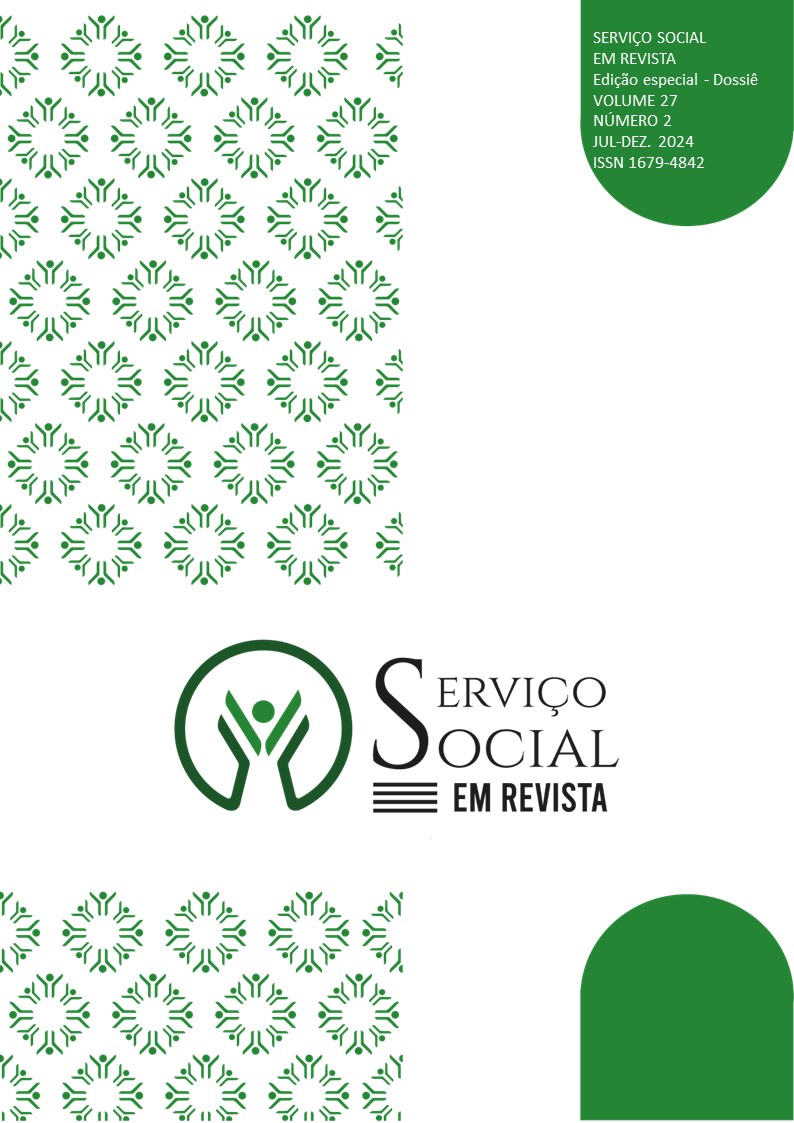August Festival in Montes Claros - MG:
the territoriality of the Catopês
DOI:
https://doi.org/10.5433/1679-4842.2024v27n2p414Keywords:
Religion, Popular Catholicism, Cultural Identity, Sacred and Profane SpaceAbstract
The aim of this article is to relate the religious territoriality of the August Festivities, breaking with the view of the territory and taking the representativeness of the Congado festivities in the city of Montes Claros-MG. Held for over 180 years, the festival has its representativeness in the history of the catopês, marujadas and caboclinhos, groups that bring together music, celebration, devotion and faith in the same ritual. The study is based on a survey of audiovisual materials, iconographic records and bibliographical references on the festival and its manifestations, contributing to the construction of a cultural memory that is affective, sacred and reaffirms the regional identity of its population and visitors. Conducting primary qualitative research with a master of the traditional religious festival made it possible to delve deeper into the study and have direct contact with the object of analysis. The data collected in the fieldwork and interviews, although partial, made it possible to clearly identify the influence of the festival on the territorial dynamics of downtown Montes Claros. The celebration promotes a reconfiguration of the urban space, altering the flow of people, boosting local commerce and significantly changing the territorial dynamism of the city downtown.
Downloads
References
BRITO, Ângela Ernestina Cardoso de. Catopês: histórias de lutas e formação de identidades em Montes Claros-MG / Ângela Ernestina Cardoso de Brito, 2014.
ELIADE, Mircea. Imagens e símbolos. Trad. Maria Adozinda Oliveira Soares. Lisboa: Arcádía, 1979.
HAESBAERT, Rogério. A desterritorialização: Entre as redes e os aglomerados de exclusão. In: CASTRO, I. E., et al., Geografia: Conceitos e temas. Rio de Janeiro: Bertrand Brasil, 1999, p. 165-206.
HAESBAERT, Rogério. Identidades territoriais. In.: ROSENDAHL, Zeny; CORRÊA, Roberto Lobato; (Orgs.). Geografia cultural: Uma antologia, volume II. Rio de Janeiro: EDUERJ, 2013.
HAESBAERT, Rogério. Identidades territoriais. In: ROSENDAHL, Zeny; CORRÊA, Roberto L. Manifestações da cultura no espaço. Rio de Janeiro: Eduerj, 1999.
HAESBAERT, Rogério. O mito da desterritorialização: do "fim dos territórios" à multi-territorialidade. 1ª edição. Rio de Janeiro: BERTRAND BRASIL, 2004.
HAESBAERT, Rogério. O mito da desterritorialização: Do "fim dos territórios" à multiterritorialidade. 2. ed., Rio de Janeiro: Bertrand Brasil, 2006.
LUCAS, Glaura. Os sons do Rosário: o congado mineiro dos Arturos e Jatobá. Belo Horizonte: UFMG, 2002.
MALVEIRA, Ricardo Ribeiro. Os catopês de São Benedito em Montes Claros: rastros de uma ancestralidade mineira negra e festiva. Dissertação de Mestrado. Universidade Federal da Bahia, 2011.
MARTINS, Saul. Congado, família de sete irmãos. Belo Horizonte: SESC, 1988.
MENDES, Jean Joubert Freitas. Música e religiosidade na caracterização identitária do Terno de Catopês de Nossa Senhora do Rosário do Mestre João Farias em Montes Claros - MG. 2004. 230 f. Dissertação (Mestrado em Música) - Programa de Pós-Graduação em Música, Universidade Federal da Bahia. Salvador, 2004.
NOVO TESTAMENTO: BÍBLIA, N. T. Mateus. In: Bíblia Sagrada. Tradução de Missionários do Imaculado Coração de Maria (Missionários Clarentianos). Editora Ave-Maria; 215ª edição (1 janeiro 2016).
ROSENDAHL, Z e CORRÊA, R.L. (orgs). A territorialidade da Igreja Católica no Brasil -1800 e 1930. Rio de Janeiro: 2003. (TEXTOS NEPEC nº1).
ROSENDAHL, Z. "Espaço, cultura e religião: dimensões de análise". In: CORRÊA, R.L. e ROSENDAHL, Z. (orgs). Introdução a geografia cultural. Rio de Janeiro: Bertrand Brasil, 2003, pp.187-224.
ROSENDAHL, Z. "Espaço, política e religião". In: ROSENDAHL, Z. e CORRÊA, R.L. (orgs). Religião, identidade e território. Rio de Janeiro: EdUERJ, 2001, pp. 9-39.
ROSENDAHL, Z. "O sagrado e o espaço". In: CASTRO, I.E., GOMES, P.C. e CORRÊA, R.L. (orgs). Explorações Geográficas. Rio de Janeiro, Bertrand Brasil. 1997, pp. 119-154.
ROSENDAHL, Z. Espaço e religião: uma abordagem geográfica. Rio de Janeiro: EdUERJ, 1996.
ROSENDAHL, Z. Hierópolis: o sagrado e o urbano. Rio de Janeiro: EdUERJ, 1999.
ROSENDAHL, Zeny. Território e territorialidade: uma perspectiva geográfica para o estudo da religião. In.: ROSENDAHL, Zeny; CORRÊA, Roberto Lobato. (Orgs.). Geografia: Temas sobre cultura e espaço. 1ª edição. Rio de Janeiro: Ed. UERJ, 2005.
SOUZA, Luis Fellipe Dias; LAURENTIZ, Luiz Carlos de. A cidade como espaço de festa: uma leitura sobre as Festas de Agosto e o Festival Folclórico de Montes Claros (MG), 2022. DOI: https://doi.org/10.4000/pontourbe.11924
WEBER, M. 1978. Economy and Society: an outline of interpretive sociology. Berkeley, University of California Press, vol. 2, 1643 p.
ZANZA JÚNIOR, João Pimenta dos Santos. Os catopês, território e cultura. Entrevista concedida a Sabrina da Silva Gonçalves. Montes Claros, 8 de agosto de 2023.
Downloads
Published
How to Cite
Issue
Section
License
Copyright (c) 2024 Sabrina da Silva Gonçalves, Ricardo Henrique Palhares, Vivian Mendes Hermano

This work is licensed under a Creative Commons Attribution-NonCommercial-NoDerivatives 4.0 International License.
A revista se reserva o direito de efetuar, nos originais, alterações de ordem normativa, ortográfica e gramatical, com vistas a manter o padrão culto da língua e a credibilidade do veículo. Respeitará, no entanto, o estilo de escrever dos autores. Alterações, correções ou sugestões de ordem conceitual serão encaminhadas aos autores, quando necessário. Nesses casos, os artigos, depois de adequados, deverão ser submetidos a nova apreciação. As provas finais não serão encaminhadas aos autores. Os trabalhos publicados passam a ser propriedade da revista Serviço Social em Revista, ficando sua reimpressão total ou parcial sujeita a autorização expressa da revista. Em todas as citações posteriores, deverá ser consignada a fonte original de publicação, no caso a Serviço Social em Revista. As opiniões emitidas pelos autores dos artigos são de sua exclusiva responsabilidade.















